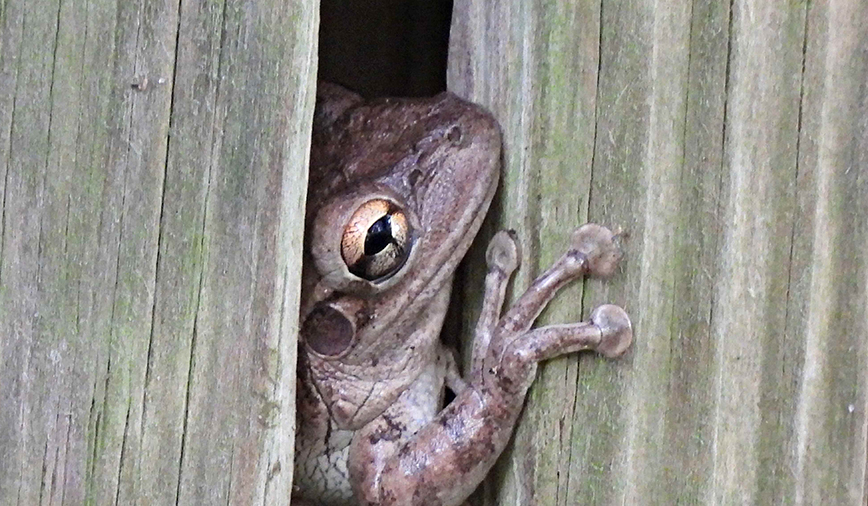Pam’s Perspective
From the…
Pam Otto is the Manager of Natural Programs and Interpretive Services for the St. Charles Park District
October 19, 2012
I think it’s safe to say, we are well acquainted with the practice of hosting visitors, and try to give each and every one the experience they desire. But lately, some of them have been more of a, shall we say…challenge?
Like any of you with box elder trees nearby, we’ve recently been visited by hundreds, if not thousands, of box elder bugs. These harmless hemipterans are on the move right now, looking for suitable spots in which to overwinter. South sides of buildings are particularly attractive, since on sunny days they are warm and also usually have gaps of one form or another that offer protection from the elements.
The internet is full of suggestions on how to diminish or even eliminate the bugs; of these, I think the most helpful one is to get rid of the weedy and pervasive box elder trees themselves. But since that solution isn’t available to us right now, and because the bugs cause no damage, we’ve adopted a position of tolerance, at least as far as the insects on the exterior are concerned.
The indoor bugs, however, may meet a slightly different fate.
Another visitor, Tenodera sinensis, a Chinese mantis, showed up a month or so ago, courtesy of the Lasare family of St. Charles. Over the past several weeks we’ve worked hard to make sure this voracious insectivore has his appetite appeased; in return he has amused and amazed us with his unerring ability to snag every sort of invertebrate we’ve dropped in front of him. Including, it turns out, box elder bugs.
A decidedly different guest, this one more secretive than the others, was spotted by our custodian Warren one night this past week. A bat apparently flew into the Hickory Knolls vestibule one evening when the door was propped open, and took up residence by the light fixture. Although our remedy
for this bat is simple—open the door again to let it fly back out—others of you might be facing the more complex issue of bats creeping into attics or fireplaces in hopes of hibernating there.
Now is the time to check these quiet, dark spaces for the presence of bats. With warmer weather forecast for later in the week, there’s still time to perform an exclusion—repairing the gaps and covering the holes the bats are using for entry while they are out foraging at night. When they return and find their entrance blocked, they will move on to more suitable accommodations.
Speaking of foraging at night, I was getting ready to leave work and go to dinner last Saturday when I ran into a couple more visitors doing the same thing. It was about 8pm, and the weather had turned warm and humid—perfect conditions for American toads and gray tree frogs to hop over and check out the bug buffet beneath the building’s exterior lighting. I found one of each, and both were busily munching away.
While I was happy to see those two thus occupied, it got me to wondering just how our other amphibian neighbors have fared over the months of drought we’ve had. On warm humid nights a year ago we could count on seeing a dozen or more ‘phibs, mainly toads, parked beneath the various lights outside. But now there were just these two, frog and toad. Are the others already tucked away for the winter? Did they move on, one way or another? I guess we’ll have to wait until next spring to know for sure.
Our final nontraditional visitor is also biding her time until winter is past. A female Blanding’s turtle—wild, not captive-bred like the Blanding’s in Hickory Knolls’ indoor turtle pond—was brought to us by Bill Graser, wildlife biologist with the Forest Preserve District of Kane County. All decked out in wonderfully deep colors of black and vivid yellow, with a radio transmitter epoxied to her shell, she had hit the road, literally, when her wetland dried up this summer. Found on pavement that likely would have brought doom, she was picked up and delivered to us for safekeeping until springtime arrives.
I know how most of us would like to spend the winter, but Ms. Blanding’s preferences are quite different. She’ll spend the next five months with no food, in darkness, at a temperature around 40F—spot-on conditions for a turtle undergoing hibernation.
Because that’s just how we treat all our visitors, seasonal or otherwise, here at Hickory Knolls. The Golden Rule states, “Do unto others as you would have them do unto you.” But we strive to go one step further, to the Platinum Rule: “Treat others as they would like to be treated.”
Even if it means 40F and no food for five months, we aim to please.
Pam Otto is the manager of nature programs, interpretive services and hospitality at the Hickory Knolls Discovery Center, a facility of the St. Charles Park District. She can be reached at 630-513-4346 or potto@stcparks.org.

